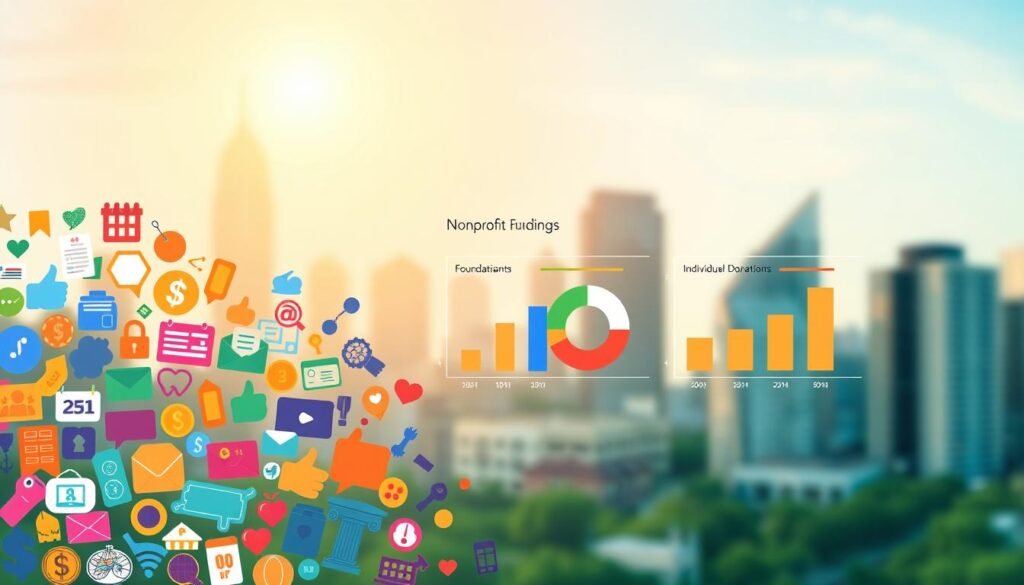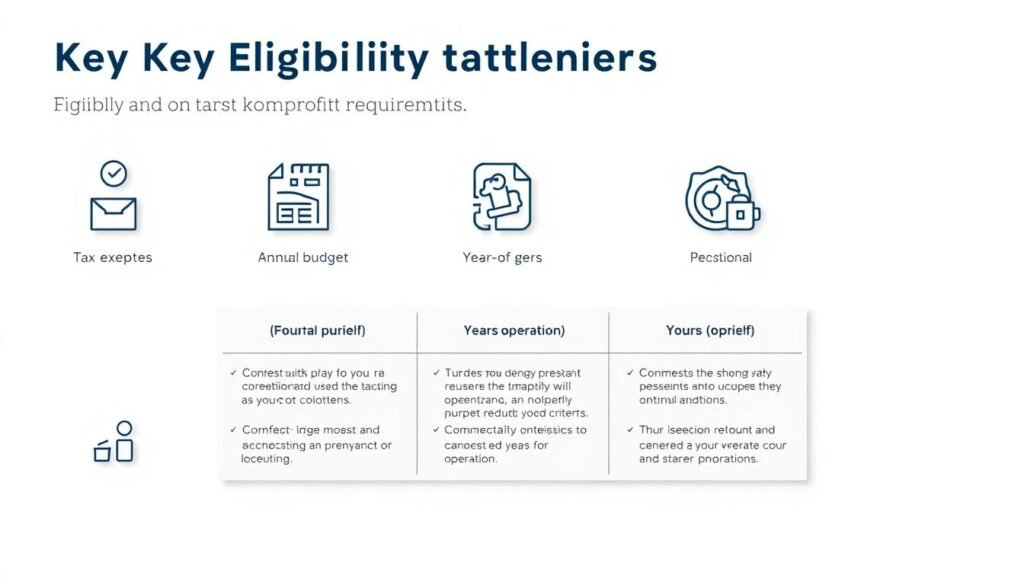Did you know over $925 billion in funding is available for organizations like yours? With thousands of opportunities waiting, securing financial support can transform your mission. But where do you start, and how can you stand out in a competitive search?
Every day, new grants open doors for impactful projects. Programs like AWS IMAGINE and Bloomberg Philanthropies offer interest-free funding, while specialized directories list 334,706 potential supporters. Over 13,000 groups already use alerts to track the best matches.
Nonprofits with 501(c)(3) status unlock 7,260+ exclusive opportunities. Current highlights include $4 million for law enforcement training, with deadlines approaching. Tools like advanced search filters and calendar reminders help streamline applications.
Key Takeaways
- $925+ billion available across 40,000+ funding sources
- Daily alerts identify time-sensitive opportunities
- 501(c)(3) status expands eligibility for specialized programs
- IRS-990 directory reveals 334,706 potential supporters
- Enhanced search tools simplify discovery of ideal matches
1. Introduction to Grants for Nonprofits
Tax-exempt awards provide critical resources to drive social change. These financial awards come from government agencies, foundations, and corporations, designed to support mission-driven work without repayment burdens.
In 2025, 9,187 active programs span 60+ categories, from education to environmental justice. Trust-based philanthropy is rising, prioritizing community expertise over rigid requirements.
To date, 641,345 recipients have secured $925 billion in grant funding. Federal sources offer 430+ awards, while 6,005+ foundation opportunities exist alongside 486 corporate-backed initiatives.
Organizations can choose between operational support or project-specific capital. Over 1,795 capital funding options are currently available for infrastructure or equipment needs.
Using tools like Foundation Directory boosts success rates by 63%. Preparation is key—501(c)(3) verification and SAM.gov registration unlock access to federal awards.
Workshops for Warriors exemplifies success, securing $400,000 through targeted searches. Their story shows how strategic research leads to transformative support.
2. Types of Grants for Nonprofits
Funding sources vary widely, each offering unique benefits for mission-driven work. Understanding these categories helps organizations target the best-fit opportunities.
Government Grants
Federal and state programs provide substantial support for community development. The Department of Justice offers $2.5 million for de-escalation training, while USDA rural initiatives fund infrastructure projects.
Key details:
- Deadline: 06/25/25 for $5M charter school grants
- Required: SF-424 forms and compliance reports
- 430+ active federal opportunities
Foundation Grants
Private foundations prioritize specific causes. The W.K. Kellogg Foundation supports food systems, and Rockefeller backs climate-resilient agriculture. Awards range from $30K fellowships to multi-year commitments.
Notable examples:
- Gates Foundation measures global health impact
- June 13 deadline for Oregon artist funding
Corporate Grants
Businesses invest in social responsibility through targeted programs. Google provides $10K monthly ad credits, while Amazon AWS awards $200K+ for tech upgrades.
Quick-turn options:
- Walmart’s 45-day review for $5K local awards
- Coca-Cola’s 2025 focus on circular economy
3. Eligibility Criteria for Nonprofit Grants
Securing financial support starts with understanding key eligibility rules. Most funders prioritize organizations that meet specific legal, geographic, or programmatic requirements. Overlooking these details can disqualify even the strongest proposals.
501(c)(3) Status Requirements
93% of foundations require valid 501(c)(3) verification. This IRS designation confirms tax-exempt status and unlocks access to 7,260+ exclusive opportunities. Ensure your determination letter is current and matches your legal name.
Groups without registration can explore fiscal sponsorship. Partnerships with established entities allow participation in restricted programs. Federal awards often need additional steps, like SAM.gov enrollment.
Geographic and Program Restrictions
Many funders limit awards to specific regions. Washington State’s maritime funding, for example, supports only Puget Sound communities. Use Census data to demonstrate your service area aligns with a funder’s priorities.
Programmatic fit is equally critical. Education awards may require Title I school partnerships, while health initiatives often follow CDC frameworks. Always cross-check guidelines before drafting proposals.
4. How to Apply for Nonprofit Grants
Crafting a winning application requires precision and strategic planning. Over two-thirds of rejections stem from budget mismatches or unclear goals. Start by aligning your project scope with the funder’s priorities.
Preparing Your Proposal
Successful submissions use SMART goals—Specific, Measurable, Achievable, Relevant, and Time-bound. Limit proposals to 10 pages, opening with a compelling executive summary.
Include a logic model to map inputs to outcomes. Federal programs often require 25% matching funds—document these early. Tools like Foundation Directory analyze IRS 990s to reveal funder preferences.
Common Application Mistakes to Avoid
Missing SAM.gov updates or DUNS numbers triggers instant rejections. Negotiate indirect cost rates upfront and demonstrate sustainability beyond the award period.
Professional writers ($75–$150/hour) can polish submissions. GrantWatch’s calendar tracks deadlines, while templates streamline compliance. Always double-check requirements before submitting.
5. Top Grants for Nonprofits in 2025
Innovative funding programs are transforming how organizations scale their impact in 2025. Leading tech and philanthropic initiatives offer tailored support for projects in education, health, and beyond. Below are three standout opportunities with proven success records.
AWS IMAGINE Grants
AWS awards $200,000 plus $100,000 in cloud credits for AI-driven social impact projects. A technical panel scores proposals using architecture diagrams from the AWS Center. The Food Bank AI demand forecasting system, a past winner, reduced waste by 37%.
Google Ad Grants
This program provides $10,000 monthly in search ads for qualifying groups. Policies prohibit branded keywords but emphasize conversion tracking. The Humane Society achieved a 9:1 ROI using targeted campaigns.
Bloomberg Philanthropies Grants
Public art installations with $500K+ budgets can apply by October 7, 2025. Recipients use Bloomberg’s impact toolkit to measure outcomes. A partnership with Local Initiatives Support Corporation expands reach to underserved communities.
6. Tips for Securing Grant Funding
Strategic engagement with funders can make or break your funding success. Beyond strong proposals, lasting partnerships and clear impact reporting drive repeat awards. Organizations that master these elements see 80% higher renewal rates.
Building Relationships with Funders
Personal connections matter more than most applicants realize. Schedule consultations before submitting proposals to align with funder priorities. Many program officers offer 30-minute calls to discuss fit.
Participate in technical webinars hosted by potential supporters. These sessions reveal unstated preferences and evaluation criteria. Maintain a stewardship calendar for regular updates, even between application cycles.
Measuring and Reporting Impact
Funders increasingly demand proof of measurable change. Develop 90-day, 180-day, and annual milestones for every funded initiative. Use balanced scorecards to track outputs and outcomes.
Visual dashboards make reports more engaging. Include client success stories with before/after comparisons. The most effective reports show how your work solves pressing community challenges.
Post-award management ensures future eligibility. Coordinate drawdown schedules with project timelines. Federal awards require SF-425 forms, while foundation grants may need narrative updates. Always complete closeout audits within 60 days of project completion.
These strategies create sustainable solutions for ongoing funding needs. Consistent communication and transparent results build trust that lasts beyond single awards.
7. Conclusion
Securing financial support becomes easier with the right tools and strategies. Organizations using comprehensive database grants see a 72% higher success rate compared to manual searches.
Take action today: create a profile on Grant Portal and set up alerts for matching opportunities. Don’t miss the June 24, 2025 deadline for law enforcement training awards.
Consider allocating part of your budget to professional writing services—this investment often pays off with stronger proposals. Ready to start? Try TGP’s enhanced search features with a free trial.
For further guidance, explore IRS EO Select Check, Candid Learning, and GrantSpace. These resources help streamline your funding journey.
FAQ
What types of financial support are available for nonprofit organizations?
Nonprofits can access government, foundation, and corporate funding. Each has unique requirements and focuses, such as education, health, or community development.
How do I know if my organization qualifies for grant funding?
Most funders require 501(c)(3) status, but some also consider geographic or program-specific restrictions. Always review eligibility criteria before applying.
What are the key steps in applying for financial support?
Start by researching opportunities, then prepare a strong proposal. Avoid common mistakes like missing deadlines or unclear project goals.
Which major funders offer support in 2025?
Top programs include AWS IMAGINE Grants, Google Ad Grants, and Bloomberg Philanthropies. Each supports different initiatives, from tech to public health.
How can nonprofits improve their chances of securing funds?
Build relationships with funders, demonstrate measurable impact, and submit polished applications that align with the funder’s mission.
Where can I find a comprehensive database of available opportunities?
Platforms like Foundation Directory Online provide searchable listings. Many government agencies also publish open calls on their websites.







